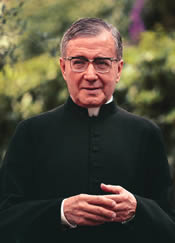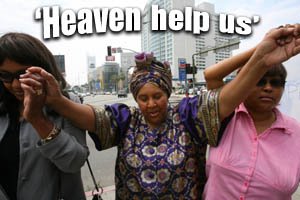
(St. Josemaria Escriva, founder of Opus Dei)
From: Los Angeles Daily News
www.dailynews.com
Without entering the priesthood, George Cassar wanted to commit his life to the work of God.
So he pledged himself to a life of celibacy, giving God every dollar beyond what he needed and turning his job into a 40-hour-a-week prayer.
"The key is trying to do the work well, do it with human perfection as Christ would do it," the Raytheon engineer said.
Cassar, a 20-year-member of Opus Dei who lives at its Tilden Study Center in Westwood, is a stark contrast to the murderous albino Silas from Dan Brown's "The Da Vinci Code."
With a film based on the book and starring Tom Hanks opening in theaters worldwide today, the Catholic Church's most controversial organization is bracing for renewed scrutiny.
Opus Dei -- literally translated in Latin as "the work of God" -- has been shrouded in mystery since its founding in 1928 by a charismatic Spanish priest named Josemaria Escriva. The group, which has about 87,000 global members, including 3,000 in the United States and 180 in Southern California, has been accused of intense recruiting, brainwashing and political puppeteering.
"Think of it as the Guinness Extra Stout of the Catholic Church. It's a strong brew, definitely an acquired taste, and clearly not for everyone," John L. Allen Jr. wrote in the introduction of his book, "Opus Dei," published last fall to dispel the myths of Brown's book.
Allen, a Vatican correspondent for the National Catholic Reporter, dedicates his book to answering the many criticisms of Opus Dei, which he argues have little merit and, in part, stem from a fear of change within the church.
"The Da Vinci Code," which Brown billed as based on previously unearthed history, claims Opus Dei exists to protect a 2,000-year-old church cover-up -- that Jesus Christ married Mary Magdalene, and that their descendents are alive today.
"I got in about 20 pages, and I couldn't read anymore. It was silly. I think it's a piece of crap," said the Rev. Paul Donlan, a Harvard-educated priest at Tilden.
Donlan, a pale man with snow-white hair, has a comical -- if a bit uncomfortable -- bond with the character Silas.
"Everybody pulls my leg, ‘Oh, you're the albino,' " Donlan joked. "The nearest I got to being an assassin was when I was a chaplain in the Marine Corps."
The core of Opus Dei servicemen, however, are not the priests but the laity, the doctors, accountants, teachers and engineers who hone their heart on serving God through sanctifying their work.
Paul Ybarra, a Los Angeles city fire captain, said he had grown tired of Sunday Christians -- those Catholics who serve God at Mass but not during the week. Then he stumbled upon Opus Dei.
"They threw down the gantlet to be a saint," said the 45-year-old Valencia father of four.
Ybarra said he learned to serve God by dedicating his firefighting to him and not himself.
"Our work is our prayer," he said.
That concept also attracted Dennis Dubro, who joined in Boston as an M.I.T. student in 1969.
Seventeen years later, though, Dubro left Opus Dei embittered by what he claimed were "extremely aggressive" and "deceitful" recruitment strategies. He also said members learned to do whatever a higher-ranking official told them but to act as if it were their choice.
"That's a whole element of the brainwashing thing: You never admit you're brainwashed," said Dubro, a 55-year-old Bay Area engineer who remains a devout Catholic.
Much speculation has been made about Opus Dei's role in the Catholic Church and its influence in global politics. Many members choose to remain anonymous because of the undesired scrutiny of claiming membership.
It is the church's only Personal Prelature, which means local officials aren't accountable to the Archdiocese of Los Angeles but to an official in Rome who reports to the pope.
Known as numeraries, about 20 percent of Opus Dei's members are celibate and single. Supernumeraries, comprising about 70 percent of members, are married and live with their families. They give to Opus Dei all income over household expenses.
The organization has worldwide assets of about $2.8 billion and of $350 million in the United States, according to Allen's book. That's only a fraction of the 2001 revenue of all U.S. Catholic programs: $102 billion.
Among Opus Dei's worldwide holdings are 15 universities, seven hospitals, 11 business schools and 36 elementary and high schools, with ambiguous names like Northridge Prep in Chicago.
They operate Tilden and 59 other study centers in 19 American cities. Most are located near prestigious universities, where Opus Dei can find young, bright minds.
Cassar was introduced to Opus Dei while attending Loyola Marymount University in the early 1980s. The group had a house in Cheviot Hills at the time, and one of Cassar's classmates invited him to visit.
"I checked them out, and it was feeding my soul," he said.
He joined in 1986 and that year helped open the Tilden Study Center, where he has lived since.
Every weekday morning, Cassar rises at 5:25. He prays for 30 minutes, attends Mass in Tilden's small chapel and shares breakfast with the eight other men who live there.
Cassar says the rosary as he sits in traffic driving from Westwood to El Segundo for work. On his desk at Raytheon are images of the Virgin Mary and St. Josemaria Escriva, whom Opus Dei members refer to as "the founder." Cassar tries to open and close doors in a way that won't disturb others.
And throughout the day he repeats mnemonic prayers, such as "He must become more" when he climbs stairs and "I must become less" when he descends them, as simple reminders to himself that his life's purpose is to serve Jesus.
"It's like an Internet connection. Maybe you had a flaky connection, the cord in the back of your computer wasn't fully plugged in. But once you get it plugged in, it shoots out all this information," Cassar said. "It's as if my eyes are not my eyes, my nose is not my nose, my ears are not my ears. They are all Christ's because I am fully connected.
"It is basically like being in the spiritual zone."


